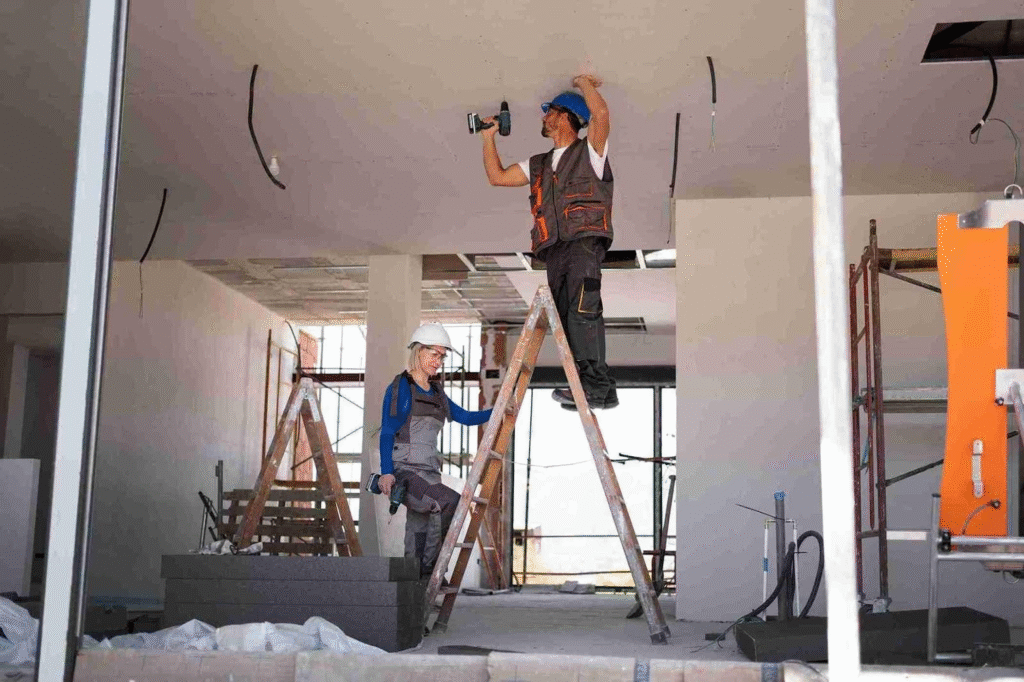Top 8 Costly Clinic Renovation Mistakes to Avoid
Quick Summary: Why Most Clinic Renovation Projects Go Over Budget (And How to Avoid It)
- Poor planning destroys budgets and timelines. Rushing into a clinic renovation without clear objectives leads to mid-project changes that can increase costs and extend downtime.
- Wrong contractor selection proves most expensive. General builders lack specialised and technical medical facility knowledge. This can lead to compliance failures and costly corrections.
- Inadequate budgeting overlooks hidden costs. Most practices focus only on equipment and finishes. All renovations require 20% to 25% contingency funds.
- Infrastructure planning determines future capabilities. Modern medical practices need improved electrical and HVAC systems that accommodate current technology plus future expansion.
- Business continuity planning prevents revenue loss. Phased construction and advanced patient scheduling maintain services throughout renovation. This protects cash flow and prevents patient defection to competitors.

Clinic renovation projects across Sydney have taught us valuable lessons over the past 35 years. While each practice has its own needs, the most expensive mistakes tend to follow predictable patterns, and knowing these pitfalls can turn your renovation from an investment into a financial burden.
Mistake #1: No Proper Planning
The excitement of renovation often leads practices to rush into clinic renovation without comprehensive planning and jumping on the bandwagon for the most popular trends. This enthusiasm, while much-needed, can become the project’s downfall.
Starting without clear objectives creates a domino effect of problems. You might discover halfway through that your beautiful reception area blocks patient flow, or that your new consultation rooms can’t accommodate equipment. Mid-project changes like these can increase costs while extending downtime that affects both patient care and revenue.
Proper planning means defining specific goals for your clinic renovation. Are you expanding patient capacity? Improving staff workflow? Enhancing patient experience? Each objective requires different design and budget allocations.
The most successful projects begin with detailed discussions involving stakeholders such as doctors, nurses, administrative staff, and even regular patients to have insights that aren’t obvious from a purely aesthetic perspective.
Smart planning also includes creating a realistic timeline that accounts for permit approvals, material deliveries, and inevitable unexpected discoveries.
Mistake #2: Poor Budgeting
Many practices focus only on obvious costs like equipment and finishes while overlooking substantial hidden expenses. Your clinic renovation budget must include permit fees, which can reach thousands of dollars for medical facilities in NSW. Council requirements, fire safety upgrades, and even accessibility improvements often mandate additional work beyond your original scope. That’s why experienced renovation teams recommend a minimum 20% contingency fund.
Don’t forget operational costs during your clinic renovation as well. You’ll likely face reduced income while areas remain inaccessible. Some practices may even need temporary facilities or extended hours to maintain patient care, adding expenses to the project.
Mistake #3: Choosing the Wrong Contractor
Selecting contractors based solely on price often proves the most expensive decision you’ll make. Medical facilities require specialised knowledge that general builders simply don’t possess. A contractor unfamiliar with these requirements will learn on your budget, creating delays and costly corrections.
Warning signs include:
- No recent medical facility projects
- Reluctance to provide healthcare references
- Unclear about infection control protocols
- Lowest quote by a significant margin
Check potential contractors’ recent medical projects and speak directly with those practice managers. Ask specific questions about timeline adherence and budget management.
Mistake #4: Focusing Solely On Aesthetics
Beautiful spaces mean nothing if they hinder your daily operations since poor space planning during clinic renovation creates workflow problems that frustrate staff and patients for years.
Patients need clear pathways from reception to consultation rooms, treatment areas, and back to reception for checkout. Confusing layouts increase wait times and create bottlenecks during busy periods.
Consider the separation between different practice functions. Your clinic renovation should create distinct zones for consultation, treatment, administration, and staff areas. This separation maintains appropriate privacy levels.
Furthermore, storage needs often receive inadequate attention during clinic renovation planning. Medical practices accumulate substantial supplies, equipment, and records. Insufficient storage leads to cluttered spaces that appear unprofessional and hinder workflow.
Finally, future flexibility matters enormously in medical spaces, and your clinic renovation should accommodate potential changes. Modular designs and adaptable infrastructure prevent expensive modifications later.
Mistake #5: Picking Wrong Materials
Standard commercial finishes often deteriorate rapidly when exposed to medical-grade disinfectants used multiple times daily. Meanwhile, flooring choices have a significant impact on long-term costs and patient comfort. Non-porous, antimicrobial surfaces prove more economical despite higher initial costs. However, other options like terrazzo, rubber, vinyl and carpet tile in patient unit corridors should still be considered since these can help with the absorption of sound, employee perceptions and preferences, and patient satisfaction, among other things.
Wall finishes need consideration beyond aesthetics. Your clinic renovation should specify materials that resist staining and maintain their appearance under harsh lighting conditions. Fire ratings and smoke development indices become critical in medical facilities. Australian building codes impose strict requirements for healthcare environments. Using non-compliant materials can force expensive retrofitting and delay your clinic renovation completion.
Finally, quality materials reduce lifecycle costs significantly. While premium healthcare-grade finishes cost more initially, they avoid frequent replacement and maintenance that disrupts operations and creates ongoing expenses.

Mistake #6: Inadequate Infrastructure
Today’s medical practices rely heavily on technology, so infrastructure planning is non-negotiable during any clinic renovation. Inadequate systems prevent you from adopting new technologies and providing optimal patient care.
Electrical capacity often proves insufficient for modern medical equipment. Digital imaging systems, sterilisation equipment, and advanced diagnostic tools require substantial power loads. Your clinic renovation must include electrical upgrades that accommodate current needs, plus future expansion.
Critical infrastructure considerations:
- Emergency backup power systems
- Specialised plumbing for medical requirements
- Medical gas and suction systems
- Redundant data networks for reliability

Mistake #7: Ignoring Patient Experience
Patient satisfaction directly impacts practice success, making experience design a critical component of clinic renovation planning.
Environments that increase anxiety or discomfort harm your reputation and patient retention. Waiting areas set the tone for entire visits. Cramped, poorly lit spaces with uncomfortable seating create negative first impressions that influence patient perceptions of care quality. Your clinic renovation should prioritise comfortable, welcoming reception areas.
Sound travels easily through medical facilities, potentially compromising confidential conversations. Proper acoustic planning during clinic renovation ensures appropriate privacy levels and reduces noise stress. Sound planning becomes even more important in wards, as it could affect patients physiologically and psychologically.
Natural light improves mood and creates positive associations with your practice, so if possible, your clinic renovation should maximise access to daylight while maintaining privacy requirements. Quality artificial lighting becomes crucial in areas without natural light access.
Lastly, wayfinding with signage reduces patient stress and staff interruptions. Confusing designs force staff to provide directions constantly, reducing their availability for other tasks.
Mistake #8: Business Continuity
Poor continuity planning can cost more than the renovation itself through lost revenue and patient defection. Phased construction allows you to maintain essential services throughout your clinic renovation. Continuity solutions require advance planning and communication with patients about temporary changes to normal operations.
Furthermore, revenue protection strategies help maintain cash flow during your clinic renovation. Some practices increase appointment frequency before construction begins, building a financial buffer for reduced capacity periods.
FAQ
Do I need council approval for medical clinic renovations in NSW?
Yes, most clinic renovations require development approval from your local council, especially those involving structural changes. Cassins can help you with this, so you can focus more on patient care.
How much should I set aside for unexpected costs during renovation?
Budget at least 20% to 25% above your estimated costs for contingencies. Medical facilities often reveal hidden issues such as outdated wiring or structural problems that weren’t part of the initial budget.
What’s the difference between medical-grade and commercial-grade materials?
Medical-grade materials are specifically designed to withstand harsh cleaning chemicals and resist bacterial growth. They typically last longer than standard commercial materials in healthcare environments.
Should I hire a separate project manager for my clinic renovation?
For projects involving multiple trades, a dedicated project manager may be needed. However, getting a reliable contractor with an open line of communication is even more important.
How far in advance should I book patients around renovation dates?
Start planning patient schedules around four to six months ahead of major construction phases to accommodate appointment density and communicate changes without losing revenue.

Every year, Sydney medical practices lose hundreds of thousands of dollars to preventable renovation mistakes. The difference between renovation success and failure lies in partnering with companies that specialise in medical facilities and practices.
Cassins has spent over three decades perfecting the art of medical facility renovation. We’ve helped hundreds of practices avoid these costly pitfalls while creating spaces that support practice growth. Your clinic renovation is a massive opportunity to advance your practice. Make it count by working with Cassins. Contact us today to begin planning your renovation.


